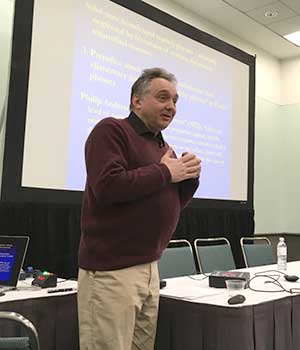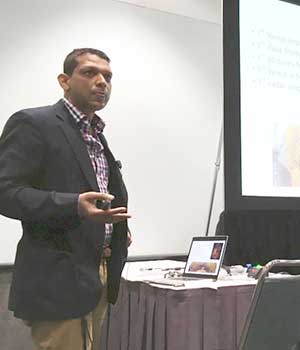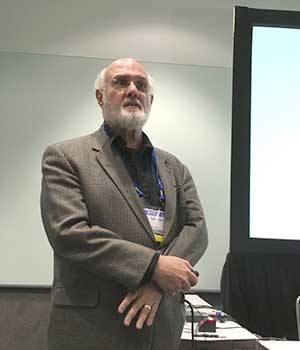March Session Reports: History of Soviet Physics
By Paul Cadden-Zimansky
The session on the history of Soviet physics at the 2018 March Meeting brought together four diverse views on a topic that spans almost a century. The first talk, by University of British Columbia historian of physics and session organizer Alexei Kojevnikov, was aimed at squarely at the predominantly condensed matter audience of the Meeting. Taking its title “More is Different” from the famous 1972 essay by Philip Anderson, Kojevnikov sought to trace back the early embrace of solid state physics in the Soviet era and some of the non-reductionist views that Anderson advocated in the U.S. only many decades later. Highlighting the role of crystallographer Abram Joffe, who was proficient at piecing together funding for scientific work at the beginning of the Soviet era from various state agencies, Kojevnikov explained how Joffe’s invention of the concept of a physicist-engineer not wedded to pursuing “pure science” helped provide a framework where individuals in the 1920s and 30s such as Vladimir Fock could pursue the “fundamental importance of approximation methods” and Yakov Frenkel could pioneer the understanding of quasiparticles. One connection of note between Soviet ideology and science was that quasiparticles were originally termed “collectivized particles.”

Alexei Kojevnikov, University of British Columbia

Samoil Bilenky, Dubna, JINR

Asif Siddiqi, Fordham University

Gerson S. Sher, National Science Foundation
Moving into the post-W.W. II era, Samoil Bilenky brought his personal remembrances of working many decades at the Dubna Joint Institute for Nuclear Research. Started in 1948 with the construction of the world’s largest proton accelerator, its existence was only revealed to foreigners in 1954 with visits from such noted physicists as Wolfgang Panofsky and Owen Chamberlain. Bilenky described a geographically isolated, but thriving environment for research that enjoyed robust government support, provided access to the latest journals from around the world, and hosted weekly visits from Landau group theorists. While Dubna is now most well known for its production and analysis of transuranic elements, Bilenky emphasized its role, starting with the arrival of Bruno Pentacorvo in the 1950s, in establishing the theory of neutrino oscillations, subsequently confirmed experimentally and the subject of the 2015 Nobel prize.
Historian Asif Siddiqi of Fordham University took up another branch of large-scale science in the post-W.W. II era: the Soviet space program. Siddiqi emphasized the fundamental paradox of the program — its successes provided some of the best advertising for the preeminence of the Soviet system, but the desire for secrecy often prevented its scientists from claiming the priority that would allow recognition of their excellence. As an example, Sergei Korolov, a lead designer of the Sputnik satellites, was unknown in the West until his death. Four case studies examining this paradox were presented, including Sergei Nikolaevich Vernov’s low-orbit radiation measurements that predated Van Allen’s discovery of the Earth’s radiation belt, and how the centralization of the space program in the mid-1960s led to a stifling of research and fewer successes until it recovered under the leadership of R. Z. Sagdeev in the 1980s.
The session ended with a presentation by Gerson Sher, who worked for many years at the National Science Foundation coordinating scientific exchange between the U.S. and U.S.S.R. Sher spoke of both his own experiences and those of scientists he’s interviewed for a forthcoming book, The Great Experiment: A Critical History of Scientific Cooperation Between the United States and the Former Soviet Union, emphasizing the positive scientific collaborations, often impeded by bureaucracy or misunderstanding on both sides. In one anecdote Sher recalled how a small grant from his office to Vladimir Braginsky provided critical for the success of LIGO and the recent observation of gravitational waves.
The articles in this issue represent the views of their authors and are not necessarily those of the Forum or APS.
